Olkiluoto 3 © Tvo.fi
There is an old saying, “a watched pot never boils”. Where nuclear power generation is concerned, it seems that a watched power plant never gets finished and goes on-line, either. Take, for instance, the Olkiluoto-3 reactor on Finland’s southwest coast. It’s not as if Finland is inexperienced with such technology. Olkiluoto-3 will be the country’s fifth nuclear reactor. This particular atomic clock seems to be running slow: it is already 12 years behind schedule, and it has now been put back again. It’s probably unfair to make comparisons with projects developed outside of a time of pandemic, but even so the delays began long before the coronavirus turned up. As recently as December 2019, the plant’s owner, Teollisuuden Voima (TVO), was predicting that the nuclear fuel would be loaded during the summer of 2020 with a view to a grid connection in November 2020, with the regular production of electricity starting before that, in March 2020. Guess what? That will not be happening, any more than the previous prediction that it would be producing power by September 2020. The experience – by no means the first where nuclear power is concerned – has not put off the believers in such technology, according to the news website Taz: there is talk of what are known as ‘small modular reactors’ (SMR) being constructed in Finland, in addition to what’s there already. However, Paul Dorfman of the UK UCL Energy Institute and co-author of a study on SMRs for the Nuclear Consulting Group, Taz claims, has estimated that small reactors would provide increasingly expensive energy because of the relative costs of SMRs in terms of materials and personnel. The report suggests that creating a supply chain to substitute for the economies of scale that obtain with large reactors would make the risk for investors even greater.

I must admit that the only nuclear plant I have ever been inside was the Ignalina Nuclear Power Plant (NPP) in Lithuania. It was a graphite-modulated light water-cooled reactor, using two Soviet-designed RBMK 1500 reactors (reaktor bolshoy moshchnosty kanalny, high-power channel reactor, an unusual Soviet design) and it was much needed to generate affordable electricity in that north western part of what was then the Soviet Union. However, doubts arose over the reactor type following the massive accident at Chernobyl in Pripyat, Ukraine, in 1986, which had involved a similar unit. There, after a blaze lasting ten days, when air finally reached the reactor core, even the graphite blocks intended to damp down the nuclear reaction caught fire. The incident was a catastrophe for some 150,000 square kilometres of territory. For the workers at the plant, a typical radiation dose was 6,000 milliSieverts (mSv), enough to kill most people in just a few weeks. A dose of 1,000 mSv would be enough to cause radiation sickness, including nausea and a lower white blood cell count but probably would not be fatal, at least not straight away. Even now, Pripyat itself remains an abandoned ghost town, toys left where children dropped them in the evacuation (which came too late), shops empty and now reclaimed by nature.
Doubts about the safety of RBMK 1500 reactors had been raised on several occasions by western experts, such as the Western European Nuclear Regulators Association. They said that the main risk of accident was associated with generic design flaws of the reactors themselves and the absence of a confinement system such as a concrete and steel dome (Chernobyl lacked one, too).

This deficiency could not technically be eliminated, they argued, nor could the plant be brought to a safety level comparable to that of western European reactors. During my visit to Ignalina, I was surprised to see engineers checking for overheating in the fuel rods by placing their hands on top of them and occasionally whisking them off again quite quickly if they were too hot. At that point, I assume, the control rods would be pushed further in to slow the reaction. It seemed a somewhat informal way of keeping tabs on the plant but I saw no thermometers being used on that occasion, although I’m sure the control room was checking temperatures in a more scientific way. It all seemed rather random. Ignalina was important to Lithuania: it produced 60% of the electricity the country needed and the power it produced was sold across the border in neighbouring countries. It was a vital source of income for the economy, especially as the prices of fossil fuel from Russia were soaring. Nuclear energy from Ignalina cost very little more than half as much as energy from coal. The newly independent Lithuania wanted to be self-sufficient in energy, no longer dependent on Moscow’s good will. However, after Chernobyl, it was decided that the plant was too dangerous, and its closure became a condition of Lithuania joining the European Union and NATO. The Ignalina nuclear power plant was decommissioned in 2009.
Olkiluoto-3 will be a European Pressurized Water Reactor, the commonest type across the world, with a power output of a massive 1,600 megawatts electric (MWe). However, when it may start producing electricity is anyone’s guess. In May 2020, Finland’s safety watchdog, STUK, reported a leaking valve in one of the cooling process components. “A leak was observed in the mechanical control valve of one of the pressuriser safety valves,” the country’s nuclear safety body said in a statement. “This is very serious,” STUK’s inspection chief, Iiro Paajanan told Reuters. The leak, he said, was in part of the reactor’s primary circuit, but it may not cause a further delay, according to the French company Areva, which, together with Siemens of Germany, is building the plant. Olkiluoto-3 will need final approvement from STUK before it can load fuel and start to produce electricity.
The delay has caused the rating agency Fitch to downgrade Teollisuuden Voima, the operating company, from stable to negative, issuing the Long-Term Issuer Default Rating (IDR) at BBB-. Standard and Poor has moved its long term credit rating from BB+ to BB; outlook negative. There has been, of course, a series of delays caused by incidents or findings, but much of the delay is down to the very slow pace of construction. Obviously, you can’t rush the construction of a nuclear plant, in much the same way as you cannot rush the business of getting a tiger to accept your human presence without it eating you . Olkiluoto-3 has already taken more than 15 years, however. If the tiger training was done at the same rate that Olkiluoto-3 is being constructed, the tiger would probably have died of old age, or at least lost most of its teeth, before you entered its compound. And Olkiluoto-3 has cost a minimum of €8.5-billion, making it the second most costly building in human history. Only a hotel complex in Mecca cost more. Teollisuuden Voima told Reuters that the nuclear fuel would be loaded in January 2020 and that it would be generating electricity by July. It’s starting to look less like a frisky tiger and more like a white elephant. A similar reactor for the French utility company EDF at Flamanville in France is also years behind schedule and billions of euros over budget. It doesn’t have to be like that: China’s first EPR reactor started to produce electricity in December 2018 and a second one joined it a year later.
NOT GOING WITH A BANG
Mind you, Olkiluoto-3 is supposed to be able to produce 10% more electricity than any other nuclear plant in Europe, and it’s reported to be 4% more efficient than the two existing reactors at the site. It is designed to provide Finland with enough electricity for a generation, with a lifespan of 60 years. There should be no fears of another Chernobyl, either: its safety features are the most advanced ever seen, with its core buildings protected against earthquakes and its dome able to stop any radioactive leak with three layers of protection. It is claimed that the protective dome would even withstand a direct hit by a crashing aeroplane. However, Areva and Siemens have been hit by a range of safety concerns, building blunders, spiralling costs and long delays. A number of key components failed to meet safety standards and the consortium came in for criticism for choosing cheap and inexperienced sub-contractors. Its goal, of helping Finland to meet its Kyoto environmental commitments, has been utterly missed. Of course, Finland has a somewhat ambivalent relationship with nuclear issues anyway. The country took no part in the negotiations that led to Europe’s nuclear non-proliferation treaty, even if the Finnish public support it. An opinion survey suggested that 84% of Finns would support signing up to the Treaty. Three of the parties in the country’s coalition government would also support it, and the view of the Parliament’s Foreign Relations Committee that the Treaty could, incidentally, harm the Non-Proliferation Treaty (NPT) was universally rejected. Nuclear weapons, however, are not the same thing as nuclear energy, even if a by-product of the latter has been historically useful in building the former.
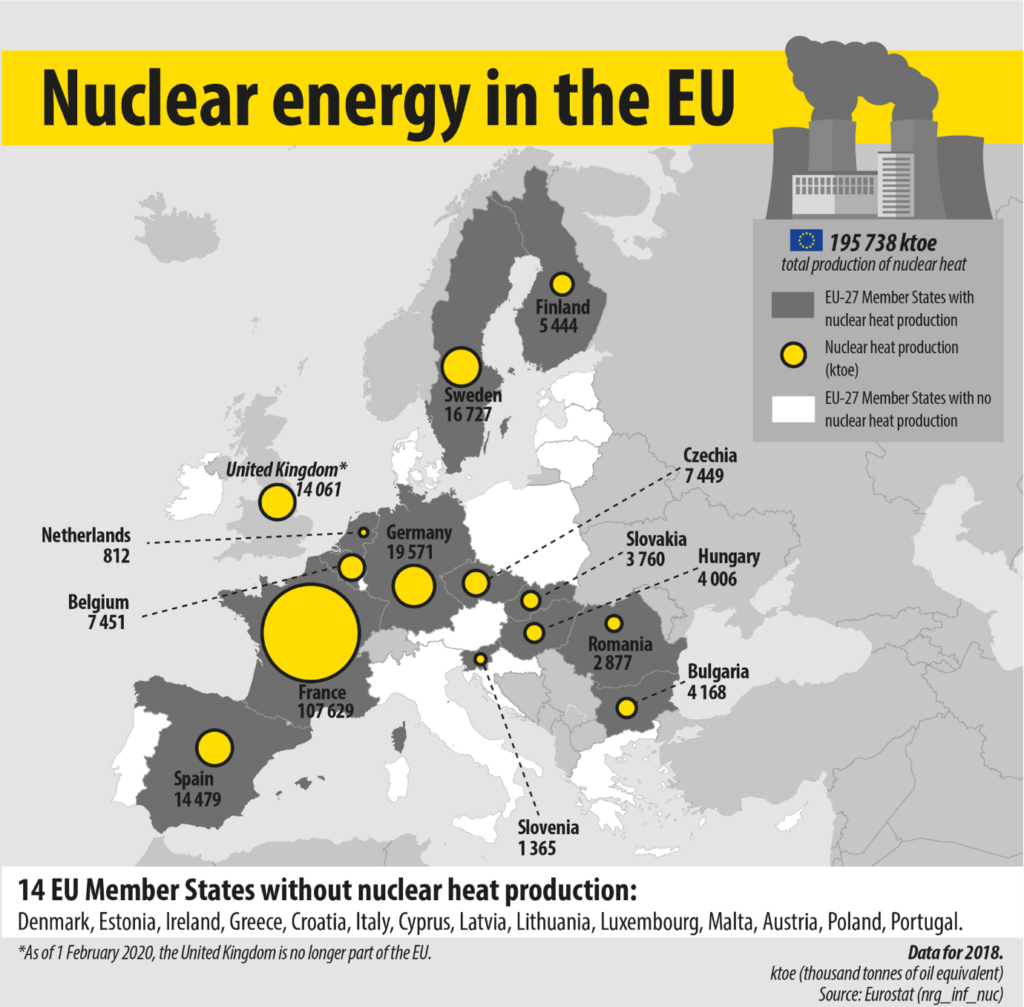
According to the helpful website Student Energy, “Today, nuclear power plants account for 11% of global electricity generation with about 80% of that installed capacity being in OECD countries. All of this capacity is nuclear fission, of course; we have yet to crack the secrets of nuclear fusion. Nuclear energy, through fission, can release 1 million times more energy per atom than fossil fuels. It can also be integrated into electricity grids, which currently utilize fossil fuel-powered power generation, with few changes to existing infrastructure.” Nuclear fission does not involve greenhouse gas emissions, so it’s often seen as ‘green energy’. But is it? Student Energy again casts doubt on the claims: “Nuclear fission has a wide variety of environmental and health issues associated with electricity generation. The largest concern is the generation of radioactive wastes such as uranium mill tailings, spent (used) reactor fuel, and other radioactive wastes. Some of these materials can remain radioactive and hazardous to both human health and the environment for thousands of years. Several large nuclear meltdowns in history released radioactive waste that had lasting negative impacts on the environment and surrounding communities. This has made nuclear fission technologies controversial.” You can say that again.
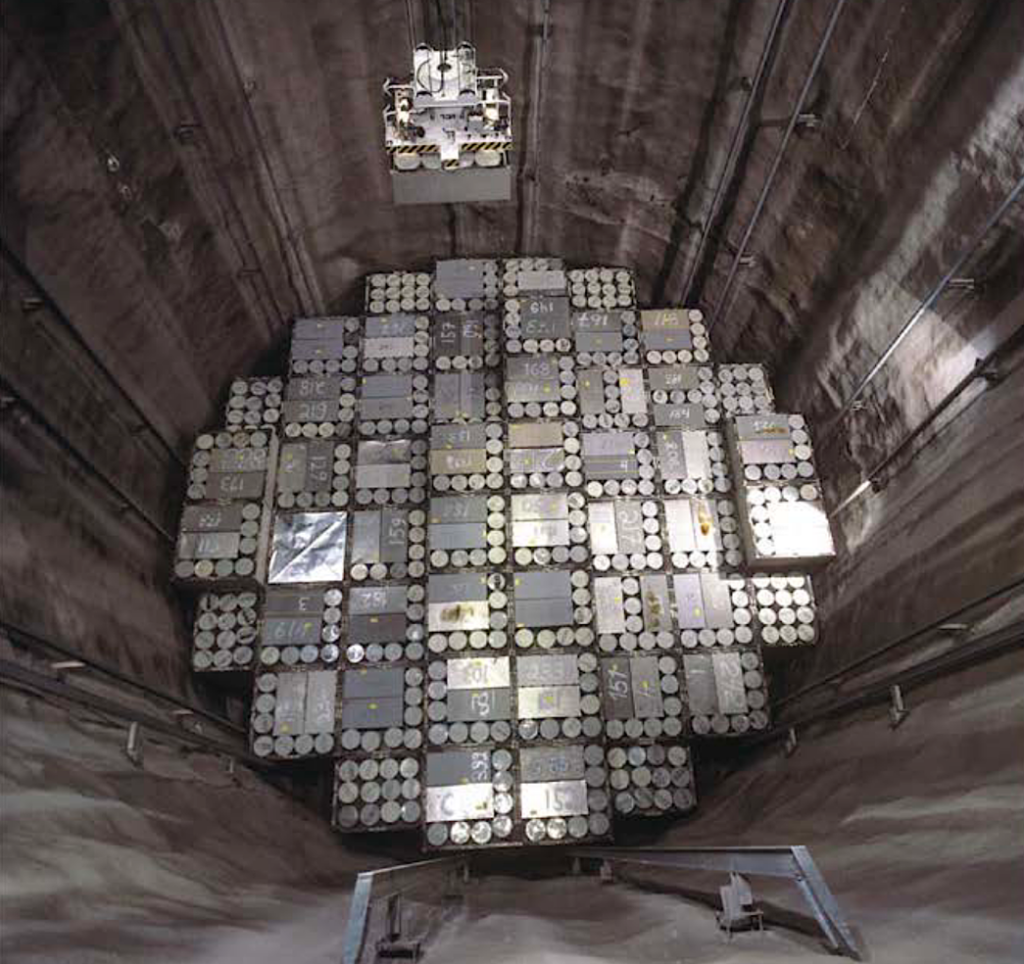
A former Scottish MEP, Struan Stevenson, told me once how he had been in Kazakhstan – he was a regular visitor – and was with a group of locals on a fact-finding trip about how the Soviet Union tested its hydrogen bombs there. He saw an odd-looking hill and ran up it, despite warnings from the rest of the party, finding when he got to the top an enormous hole in the ground. His guides urged him to get away quickly: it was the site of a Soviet nuclear weapon test and the radioactivity there was extremely high. Back home in Scotland, he went to see his doctor and was then checked over at a hospital. So high had been his radiation dose during that brief exposure that he was warned not to have an X-ray for at least two years, and only then after another examination for tissue damage. Nuclear pollution tends to hang around. Radioactive decay of fission products and elements formed in a reactor yield heat even after fission has ceased.
Basically, a nuclear reactor is there to generate heat, producing steam that drives a simple turbine, much like the waterwheels of old. The only difference from a coal or gas-powered power station is the source of heat, in this case nuclear chain reactions that produce the required heat through fission, a physical process. How it works is explained by the United States Office of Nuclear Energy like this: “Small ceramic pellets (of uranium-235) are stacked together into sealed metal tubes called fuel rods. Typically, more than 200 of these rods are bundled together to form a fuel assembly. A reactor core is typically made up of a couple hundred of such assemblies, depending on power level. Inside the reactor vessel, the fuel rods are immersed in water which acts as both a coolant and moderator. The moderator helps slow down the neutrons produced by fission to sustain the chain reaction.” The natural radioactive decay of uranium, caused by the weak nuclear force, is a major source of the Earth’s internal heat, causing vulcanism and plate tectonics. Basically, the principle of nuclear power generation is not so far removed from a nuclear weapon and relies on what must be the best-known equation in history: E = MC2. In other words, mass and energy are related in a proportion equal to the speed of light squared, although most people who can quote the equation – from Einstein’s Special Theory of Relativity, not his later and more important General Theory – haven’t a clue what it means, and even if they do, couldn’t easily explain it. Heavy elements, such as uranium, hold excess energy that can be released in huge amounts when they are broken up into smaller pieces. To get atoms to split, they are bombarded with slow-moving neutron particles which can be absorbed (fast-moving ones bounce off). The extra neutrons make the nucleus unstable, causing it to break up, releasing more neutrons which then wander off to repeat the process with other uranium nuclei, thus creating a chain reaction that is self-sustaining. To make sure this doesn’t lead to a huge explosion, a ‘moderator’ – usually water but it can also be graphite or even ‘heavy water’ (a form of water that contains only deuterium rather than the common hydrogen-1 isotope)
– is used to filter the number of neutrons and stop the reaction from going ‘bang’. It reduces the speed of fast neutrons without capturing them, leaving them as thermal neutrons with only very little (thermal) kinetic energy. In terms of energy generation, it’s very efficient: a single kilogram of uranium fuel can provide as much energy as more than 1,500 tonnes of coal. If you think humankind have created a monster, nature got there first. According to Paul Parsons and Gail Dixon, in their fascinating book ‘The Periodic Table’, “there is evidence that, 1.7-billion years ago, rich natural uranium deposits beneath the ground at Oklo in Gabon, Africa, spontaneously ignited a nuclear chain reaction, moderated by natural running water.” Isn’t nature wonderful?
TOMORROW AND TOMORROW AND TOMORROW
It was Shakespeare’s Macbeth who said
“Tomorrow and tomorrow and tomorrow
Creeps in this petty pace from day to day
To the last syllable of recorded time”
Those anticipating the fuelling and launch of Finland’s 1.6 GW Olkiluoto-3 nuclear power plant must be feeling much the same as the Thane of Cawdor (and Glamis). Electricity generation is now scheduled to begin in February 2022, 11 months behind the most recent schedule, according to project owner Teollisuuden Voima Oyj, or TVO. Few expect that timetable to survive further difficulties. Apart from being more than 12 years behind schedule, it is also three times over its original €3.2-billion budget. The unit was originally scheduled to begin commercial operations in May 2009. We must hope the rest of that Macbeth quote doesn’t come to fruition:
“And all our yesterdays have lighted fools
The way to dusty death.”
In fact the latest estimate suggests fuel should begin loading in March, 2021, eleven months before power generation begins. Hopefully. “Of approximately 3,000 commissioning tests, only a few dozen remain,” TVO’s project director for the plant, Jouni Silvennoinen, told the S&P Global website. World Nuclear News (WNN) seems less convinced about the start date. “TVO also noted that the new management of Areva actively continues working on a plan, with support of all parties, to secure funding until the end of the OL3 project,” it states on its website. “TVO has participated in the discussion of the Areva-Siemens consortium’s measures and has a positive attitude towards their progress.” The whole plant supplier consortium, Areva GmbH, Areva NP SAS and Siemens AG, is tied to a fixed-price turnkey contract. “They have joint liability for the contractual obligations until the end of the guarantee period of the unit. The consortium began construction of Olkiluoto-3 in 2005. Completion of the reactor was originally scheduled for 2009, but the project has had various delays and setbacks,” says WNN. In common with every other project around the world at present, the construction, modification and eventual commissioning of the plant are being delayed by the COVID-19 pandemic. “Works at Olkiluoto 3 site have not completely proceeded as planned,” TVO told WNN, adding a large number of measures had been taken to prevent the spread of COVID-19. “The coronavirus pandemic may have significantly added uncertainty to the progress of the project,” it said, as if it had not enough uncertainty of its own. It’s not as if EPR reactors are untried. “In December 2018, unit 1 of the Taishan plant in China’s Guangdong province became the first EPR to enter commercial operation,” reports WNN. “Taishan 2 began commercial operation in September 2019. The loading of fuel into the Flamanville EPR in France, construction of which began in December 2007, is now scheduled for the end of 2022. Two EPR units are also under construction at the Hinkley Point C project in Somerset, UK.” In the UK case, one imagines that nobody is expecting early completion ahead of schedule?
As for TVO, it’s not all been negative, as the ‘Power’ website reported, despite recent gloom over further problems and delays. “TVO announced some good news in May (2020), however. It said vibration detected in the cooling circuit’s pressurizer surge line during hot functional testing in the first half of 2018 would be eliminated using ‘liquid absorbers’. The company reported that the bitumen material used in the absorbers had been approved by the Finnish Radiation and Nuclear Authority (STUK).”
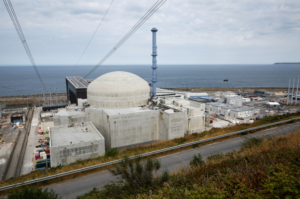
The reactor being built at Flamanville in France, where work began in December 2007, is also delayed, of course. It was originally expected to start commercial operation in 2013, but its latest holdups concern ‘weld quality deviations’. In December, 2018, the owners, Electricité de France (EdF) submitted to the Autorité de Sûreté Nucléaire (ASN) a technical file presenting the procedures for repairing and upgrading the main secondary circuit welds, which had showed deficiencies with respect to break preclusion requirements, as reported in ‘Power’. The company also submitted the specific justification method for the eight welds located in the reactor containment building structure. ‘Power’ also reported on proposed solutions to the Flamanville problems. “Earlier this month, EDF reportedly asked ASN about the possibility of repairing the welds in 2024, after the unit was commissioned. While ASN said that would be technically feasible, it would pose a number of problems, notably with regard to demonstrating the safety of the reactor during the interim period. In a statement, EDF said it ‘is currently analysing the impact of this decision on the Flamanville EPR schedule and cost, and, in the upcoming weeks, it will give a detailed update on the next steps in the project.’”
Meanwhile, a French-owned nuclear operating company, Framatome, which is owned by EdF, has signed a series of service contracts with the Finnish utility company, TVO, for the long-term operation of Olkiluoto-3. “These contracts cover nuclear plant outage and maintenance scopes, including engineering, I&C (information and communication) and non-destructive testing services over an extended period of time,” according to the website Power Engineering. ‘These contracts mark an important step as we work with TVO to prepare for the operation of the EPR at Olkiluoto 3,’ said Bernard Fontana, CEO of Framatome.
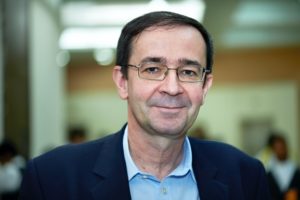
‘This strengthens the partnerships among our teams as we work together to provide innovative and efficient technologies and services for the safe, reliable and low-carbon operations of Olkiluoto-3’.” But of course, it’s the continuing series of delays that are making headlines.
“TVO said issues that have caused delays in the project schedule are: slowly progressing system testing; technical problems that have been identified in tests; and the increase in the amount of maintenance work caused by project delay,” reports WNN. “The lack of necessary spare parts has also caused delays. However, it added: ‘Technical problems that have emerged on the plant unit have now been solved, and the repair works are currently ongoing. Technical problems have been related to sea water system equipment; cracks in the pressuriser safety valves’ spring-loaded pilot control valves; faulty components in emergency diesel generators and the pressuriser surge line vibration problem. Faulty cable insulation has been detected in certain automation cabinets and these will be repaired during the autumn’.”
FOREST SPIRITS, FOREST SECRETS
One might almost start believing in traditional Finnish folk tales, where troll-like entities deliberately cause problems for humans. Take the hiisi, for instance (the plural is hiidet), a goblin with a tendency to make things go wrong, just for his (its?) amusement. Hiidet are also blacksmiths, making mainly evil things and damaging things that are good. When Tolkein’s books were translated into Finnish, the goblins (Tolkein called them goblins in The Hobbit but ‘orcs’ in Lord of the Rings) were translated as hiidet, and, like them, lived in caves underground. Tolkein was influenced by Finnish folklore and his hobbits bear an uncanny resemblance to Menninkäinen, forest dwellers, short of stature, often wearing pointy hats and keen on puzzles and dancing, although choosing to avoid humans. In the folk tales, though, they weren’t all good, sometimes luring children away into the forest where they got lost. It seems unlikely, though, that a hiisi, even if it is traditionally a metalworker, is responsible for unsafe welds.
We must not forget, of course, that Olkiluoto-3, although the largest nuclear generating plant, is not the only one in Finland (or will not be when it finally starts operating). There are four others, two of them situated on the same island as Olkiluoto-3. “Nuclear power is an important source of energy in Finland,” states the United Nations Economic Commission for Europe (UNECE). “Finland has four nuclear power plants in operation with a total electrical output of 2,700 MW, providing 27% of Finnish electricity.
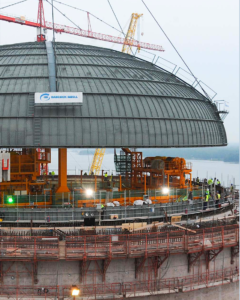
One nuclear power plant is under construction (Olkiluoto-3) and three are being assessed (Olkiluoto-4, Loviisa-3 and Fennovoima).” The existing plants already enjoy a good reputation, says the World Nuclear Association (WNA). “Finland’s four existing reactors are among the world’s most efficient, with an average lifetime capacity factor of over 90% and average capacity factor over the last ten years of almost 95%. Two boiling water reactors (BWRs) supplied by the Swedish company Asea Atom are operated by Teollisuuden Voima Oy (TVO); and two modified Russian pressurized water reactors (VVER) with Western containment and control systems are operated by Fortum Corporation.” The WNA has high praise for Finland’s existing nuclear facilities, partly for their adaptability. On Loviisa, they are Pressurised Water Reactors. “Fortum’s two VVER-440 reactors at Loviisa have been uprated 18% from their design capacity of 420 net (465 MWe gross) in 1977-80 to 507 MWe net (531 MWe gross). They have an expected operating lifetime of 50 years. A 20-year licence extension was granted by the Radiation and Nuclear Safety Authority (STUK) in mid-2007, taking them to 2027 and 2030, subject to safety evaluation in 2015 and 2023.” It’s all part of a plan to make a zero-carbon future possible for Finland by 2035, although not all of the government’s actions have pleased the energy suppliers, says the WNA. “A windfall profits tax on nuclear and hydro capacity built before 2004 was introduced in December 2013. All generators receive free CO2 emission allowances, and those not emitting CO2 can sell them. In the case of nuclear and hydro (but not wind and biomass) this is deemed a windfall profit and will be taxed to raise about €50 million per year. Fortum and TVO have protested.” Of course, they have.
It was back in 2003 that TVO announced that Framatome ANP’s 1600 MWe European Pressurized Water Reactor (EPR) was the preferred reactor on the basis of operating cost. No-one could have predicted the long delays or the obstacles that have arisen. But this troubled plant is not the last chapter in Finland’s post-carbon story. “TVO’s 2008 application for a Decision in Principle to construct a 1000-1800 MWe PWR (pressurised water reactor) or BWR (boiling water reactor) unit as Olkiluoto 4 was granted in May 2010,” WNA says. “TVO was looking at building another EPR (third generation pressurised water reactor of about 1650 MWe), but was also considering Toshiba’s version of the ABWR (advanced boiling water reactor of approximately 1650 MWe), GE-Hitachi’s ESBWR (economic simplified boiling water reactor of approximately 1650 MWe), Mitsubishi’s EU-APWR (EU advanced pressurised water reactor of approximately 1650 MWe) and the slightly smaller Korean APR-1400 (advanced power reactor of approximately 1450 MWe) – all these net capacity figures, from TVO. In March 2012 TVO formally requested bids and received five in January 2013.” To those of us not very cognizant with reactor varieties on the market, it’s just a series of letters and numbers, but it’s important for the operating companies. In any case, it looks as if Olkiluoto-3 is not the end of the story, which has turned into a saga of the sort of duration previous generations of Finns gathered around the hearth in a lord’s hall might have expected. For the consumers, all that matters is that the lights come on at the flick of a switch.
Meanwhile, the problems seem to swarm around the troubled plant and its troubled owner like the mosquitos that haunt Finnish lakeside campsites. “The construction has been plagued with a long list of problems,” says Euractiv, “including issues with the sea water system equipment, while cracks were also found in the pressurizer safety valves. Faulty components in emergency diesel generators and the vibration in the pressurizer surge line, were also found.” Some doomsayers are predicting that the plant will never be operational, although this seems unlikely; too much is riding on it and it is largely completed. “If the plant ever sees the light of day, it will produce around 30% of Finland’s electricity, which would make it the country’s ‘largest single climate action’,” Euractiv reports.

What about the nuclear waste material from Olkiluoto? The island is surrounded on three sides by the Baltic Sea and the nearest mainland town is Rauma, but in the middle of the island, in a desolate area, shrouded in pine forest, is the metal shutter that is the entrance to Onkalo, which means ‘cavity’ in Finnish. Ass names go, it’s a bit of an understatement, really. It is designed to comprise 60 to 70 kilometres of tunnels, where nuclear waste from all of Finland’s reactors will be put into storage over the next 100 years. According to Wired, “By the time the final disposal is completed, 3,250 canisters will have been deposited in the tunnels. The canisters will contain around 6,500 tonnes of uranium. The main access tunnel will be backfilled with rubble and concrete, and the entrance sealed.” And there it must stay for an astonishing 100,000 years. There’s nothing like a bit of long-term planning. As Wired points out, the oldest Egyptian pyramid has lasted just 4,500 years, Stonehenge perhaps 5,000. Onkalo must last forever. By comparison, the wait for Olkiluoto 3 seems like just a mere breath.

